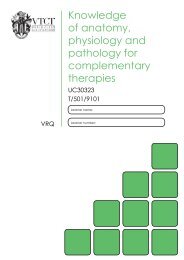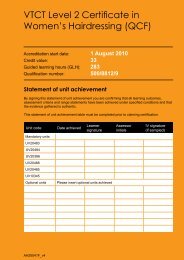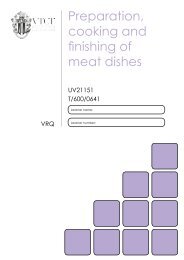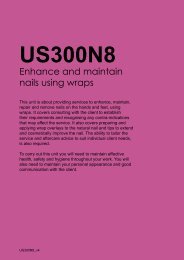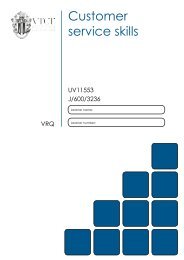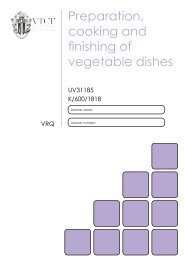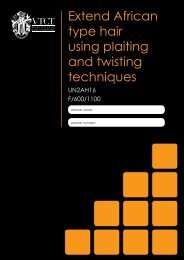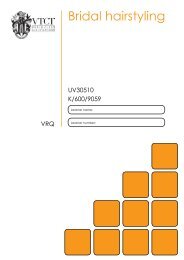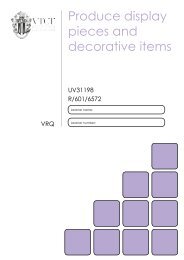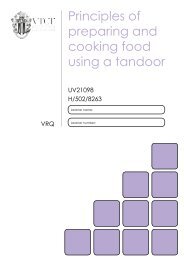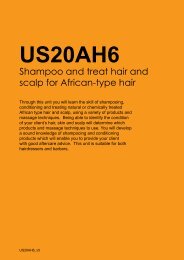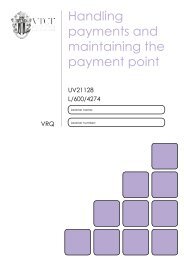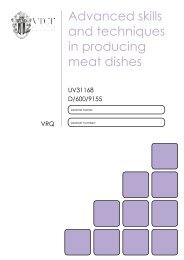Create basic patterns in hair
Create basic patterns in hair
Create basic patterns in hair
You also want an ePaper? Increase the reach of your titles
YUMPU automatically turns print PDFs into web optimized ePapers that Google loves.
US2AH21<br />
<strong>Create</strong> <strong>basic</strong> <strong>patterns</strong> <strong>in</strong> <strong>hair</strong><br />
Through this unit you will develop the artistic skill of cutt<strong>in</strong>g<br />
<strong>patterns</strong> <strong>in</strong>to African type <strong>hair</strong>. Be<strong>in</strong>g able to identify the<br />
condition of your client’s <strong>hair</strong>, sk<strong>in</strong> and scalp will determ<strong>in</strong>e<br />
which tools and techniques to use. You will design and<br />
create curves and straight l<strong>in</strong>es as part of the service.<br />
Provid<strong>in</strong>g your client with good aftercare advice forms a<br />
large part of this service.<br />
US2AH21_v4
NOS<br />
AH21<br />
SCQF Level<br />
5<br />
SCQF Credit po<strong>in</strong>ts<br />
4<br />
Observations<br />
3<br />
External paper(s)<br />
1<br />
Photo courtesy of Wahl (UK) Ltd.
<strong>Create</strong> <strong>basic</strong> <strong>patterns</strong> <strong>in</strong> <strong>hair</strong><br />
Learn<strong>in</strong>g outcomes Evidence requirements<br />
On completion of this unit you will:<br />
1. Be able to use effective and safe work<strong>in</strong>g<br />
methods when colour<strong>in</strong>g <strong>hair</strong><br />
2. Be able to plan and agree <strong>hair</strong> pattern<br />
designs with the client<br />
3. Be able to create <strong>patterns</strong> <strong>in</strong> <strong>hair</strong><br />
4. Know salon and legal requirements<br />
5. Know how to work safely, effectively and<br />
hygienically when cutt<strong>in</strong>g <strong>hair</strong><br />
6. Know how to create designs <strong>in</strong> <strong>hair</strong><br />
7. Know the <strong>hair</strong> and sk<strong>in</strong><br />
8. Know about preparation, cutt<strong>in</strong>g techniques<br />
and problem solv<strong>in</strong>g<br />
9. Know how to communicate with clients and<br />
provide <strong>in</strong>formation<br />
1. Simulation is not allowed for any<br />
performance evidence with<strong>in</strong> this unit.<br />
2. You must practically demonstrate <strong>in</strong> your<br />
everyday work that you have met the<br />
standard for creat<strong>in</strong>g <strong>basic</strong> <strong>patterns</strong> <strong>in</strong> <strong>hair</strong>.<br />
3. Your assessor will observe your<br />
performance on at least 3 occasions, all<br />
of which must be of different <strong>patterns</strong><br />
each cover<strong>in</strong>g 25% of the head and 1<br />
must <strong>in</strong>clude the use of curved l<strong>in</strong>es.<br />
4. From the range, you must show that you<br />
have:<br />
• used all the tools and equipment listed<br />
• taken <strong>in</strong>to account all the factors listed<br />
• created all the types of <strong>patterns</strong> listed<br />
• used all the cutt<strong>in</strong>g techniques listed<br />
• given advice cover<strong>in</strong>g all the areas listed<br />
5. It is most likely evidence of your<br />
performance will be gathered from the<br />
observations made by your assessor but<br />
you may be required to produce other<br />
evidence to support your performance if<br />
your assessor has not been present.<br />
6. Knowledge and understand<strong>in</strong>g <strong>in</strong> this unit<br />
will be assessed by an external paper.<br />
The criteria that make up this paper are<br />
highlighted <strong>in</strong> white throughout this unit.<br />
There is one external paper that must be<br />
achieved.<br />
US2AH21<br />
3
4<br />
Achiev<strong>in</strong>g observations<br />
and range<br />
Achiev<strong>in</strong>g observation outcomes<br />
Your assessor will observe your performance<br />
of practical tasks. The m<strong>in</strong>imum number<br />
of observations required is <strong>in</strong>dicated <strong>in</strong> the<br />
evidence requirements section of this unit.<br />
Criteria may not always naturally occur dur<strong>in</strong>g<br />
a practical observation. In such <strong>in</strong>stances you<br />
will be asked questions to demonstrate your<br />
competence <strong>in</strong> this area. Your assessor will<br />
document the criteria that have been achieved<br />
through oral question<strong>in</strong>g.<br />
Your assessor will sign off an outcome when all<br />
criteria have been competently achieved <strong>in</strong> a<br />
s<strong>in</strong>gle client service.<br />
Achiev<strong>in</strong>g range<br />
The range section <strong>in</strong>dicates what must<br />
be covered. Ranges must be practically<br />
demonstrated as part of an observation. Your<br />
assessor will document the portfolio reference<br />
once a range has been competently achieved.<br />
US2AH21<br />
Maximum service times<br />
There are no maximum service times that apply<br />
to this unit
Outcome 1<br />
You can:<br />
a. Protect the client’s cloth<strong>in</strong>g throughout the<br />
service<br />
b. Ensure the client’s sk<strong>in</strong> is kept free of<br />
excess <strong>hair</strong> cutt<strong>in</strong>gs throughout the service<br />
c. Clean and tidy the work area throughout the<br />
service<br />
d. Position client’s and adopt postures that<br />
m<strong>in</strong>imise fatigue, discomfort and <strong>in</strong>jury risk<br />
e. Use work<strong>in</strong>g methods that:<br />
− m<strong>in</strong>imise the wastage of products<br />
− m<strong>in</strong>imise the risk of cross-<strong>in</strong>fection<br />
− make effective use of the work<strong>in</strong>g time<br />
− ensure the use of clean resources<br />
− m<strong>in</strong>imise the risk of harm or <strong>in</strong>jury to<br />
self and clients<br />
f. Ma<strong>in</strong>ta<strong>in</strong> personal standards of health and<br />
hygiene which m<strong>in</strong>imise the risk of cross<strong>in</strong>fection,<br />
<strong>in</strong>festation and offence to their<br />
clients and colleagues<br />
g. Use tools that are safe, sterile and fit for<br />
purpose<br />
*May be assessed through oral question<strong>in</strong>g.<br />
Observations<br />
Be able to use effective and safe work<strong>in</strong>g methods when<br />
colour<strong>in</strong>g <strong>hair</strong><br />
h. Complete the cutt<strong>in</strong>g service <strong>in</strong> a<br />
commercially viable time<br />
i. Remove waste immediately at the end of the<br />
cutt<strong>in</strong>g service<br />
j. Ma<strong>in</strong>ta<strong>in</strong> accurate and up to date client<br />
records at the end of the service<br />
Observation<br />
Criteria questioned orally<br />
Date achieved<br />
Portfolio reference<br />
Learner signature<br />
Assessor <strong>in</strong>itials<br />
1 2 3<br />
US2AH21<br />
5
6<br />
© Habia<br />
Outcome 2<br />
Be able to plan and agree <strong>hair</strong> pattern designs with the client<br />
You can:<br />
a. Present a portfolio of visual aids to explore<br />
different <strong>patterns</strong> and design possibilities<br />
with the client<br />
b. Provide time and encouragement so that<br />
clients can suggest their own ideas on<br />
design and image<br />
c. Evaluate the client’s <strong>hair</strong> and its potential to<br />
achieve the pattern<br />
d. Recommend and confirm a look that is<br />
suitable for the client’s perceived image<br />
e. Confirm the client is aware of the agreed<br />
service process, outcomes, duration and<br />
cost<br />
f. <strong>Create</strong> a pattern with the client which takes<br />
<strong>in</strong>to account <strong>in</strong>fluenc<strong>in</strong>g factors<br />
*May be assessed through oral question<strong>in</strong>g.<br />
Observation 1 2 3<br />
Criteria questioned orally<br />
Date achieved<br />
Portfolio reference<br />
Learner signature<br />
Assessor <strong>in</strong>itials<br />
US2AH21
Outcome 3<br />
Be able to create <strong>patterns</strong> <strong>in</strong> <strong>hair</strong><br />
You can:<br />
a. Use brush<strong>in</strong>g and comb out techniques<br />
suitable for the desired pattern<br />
b. Position the pattern to meet the agreed<br />
design plan<br />
c. Adapt the size of the pattern to suit the<br />
client’s head size, shape and exist<strong>in</strong>g<br />
<strong>hair</strong>cut<br />
d. Use cutt<strong>in</strong>g techniques to achieve the<br />
def<strong>in</strong>ition, shape and depth of pattern<br />
required<br />
e. Adapt own and client position to ensure the<br />
accuracy of the cut<br />
f. Consult with the client throughout the cutt<strong>in</strong>g<br />
process to confirm the desired pattern and<br />
overall effect be<strong>in</strong>g created<br />
g. Resolve problems aris<strong>in</strong>g dur<strong>in</strong>g the cutt<strong>in</strong>g<br />
process *<br />
h. Confirm the f<strong>in</strong>ished look meets the pattern<br />
agreed with the client<br />
i. Provide the client with suitable aftercare<br />
advice<br />
*May be assessed through oral question<strong>in</strong>g.<br />
Observation 1 2 3<br />
Criteria questioned orally<br />
Date achieved<br />
Portfolio reference<br />
Learner signature<br />
Assessor <strong>in</strong>itials<br />
Photo courtesy of Wahl (UK) Ltd.<br />
US2AH21<br />
7
8<br />
Range<br />
You must practically demonstrate that you have:<br />
Used all the tools and equipment Portfolio reference<br />
Scissors<br />
Clippers<br />
T-l<strong>in</strong>ers<br />
Taken <strong>in</strong>to account all the factors Portfolio reference<br />
Head and face shape<br />
Hair growth <strong>patterns</strong><br />
Hair density<br />
Hair length<br />
Hair texture<br />
Presence of male pattern baldness<br />
Sk<strong>in</strong> disorders<br />
Scarr<strong>in</strong>g<br />
<strong>Create</strong>d all the types of <strong>patterns</strong> Portfolio reference<br />
Straight l<strong>in</strong>es<br />
Curved l<strong>in</strong>es<br />
Used all the cutt<strong>in</strong>g techniques Portfolio reference<br />
Clipper over comb<br />
Scissor over comb<br />
Freehand<br />
Fad<strong>in</strong>g<br />
Given advice cover<strong>in</strong>g all the areas Portfolio reference<br />
Time <strong>in</strong>terval between cuts<br />
Groom<strong>in</strong>g requirements<br />
Potential for pattern change<br />
US2AH21
Achiev<strong>in</strong>g knowledge outcomes<br />
You will be guided by your tutor and assessor<br />
on the evidence that needs to be produced.<br />
Your knowledge and understand<strong>in</strong>g will be<br />
assessed us<strong>in</strong>g the assessment methods listed<br />
below:<br />
• Observed work<br />
• Witness statements<br />
• Audio-visual media<br />
• Evidence of prior learn<strong>in</strong>g or atta<strong>in</strong>ment<br />
• Written questions<br />
• Oral questions<br />
• Assignments<br />
• Case studies<br />
Achiev<strong>in</strong>g the external paper<br />
Develop<strong>in</strong>g knowledge<br />
Where possible your assessor will <strong>in</strong>tegrate<br />
knowledge outcomes <strong>in</strong>to practical observations<br />
through oral question<strong>in</strong>g.<br />
The external paper will test your knowledge of the criteria highlighted <strong>in</strong> white. A pass mark of<br />
70% must be achieved. Criteria not achieved will be identified to your tutor/assessor. You will<br />
then be orally questioned or asked to produce other forms of evidence as all unit criteria must be<br />
achieved.<br />
Your assessor will complete the table below when the 70% pass mark has been achieved.<br />
Paper Date achieved Assessor <strong>in</strong>itials<br />
1 of 1<br />
US2AH21 9
10<br />
Knowledge<br />
Outcome 4<br />
Know salon and legal requirements<br />
You can:<br />
a. Describe the salon's requirements for client preparation<br />
b. Describe the salon's expected service times for cutt<strong>in</strong>g <strong>patterns</strong> <strong>in</strong><br />
<strong>hair</strong><br />
c. Describe the salon’s and legal requirements for disposal of sharps<br />
and waste materials<br />
d. State personal responsibilities under current Electricity at Work<br />
Regulations<br />
* Assessor <strong>in</strong>itials to be <strong>in</strong>serted if orally questioned.<br />
Requirements highlighted <strong>in</strong> white are assessed <strong>in</strong> the external paper.<br />
US2AH21<br />
Portfolio reference /<br />
Assessor <strong>in</strong>itials*
Outcome 5<br />
Know how to work safely, effectively and hygienically when<br />
cutt<strong>in</strong>g <strong>hair</strong><br />
You can:<br />
a. Outl<strong>in</strong>e the types of personal protective equipment that should be<br />
available for clients and yourself<br />
b. Describe why it is important to protect clients from <strong>hair</strong> clipp<strong>in</strong>gs<br />
c. Describe how own and client position<strong>in</strong>g can affect the desired<br />
outcome and reduce fatigue and <strong>in</strong>jury risk<br />
d. Describe why it is important to position cutt<strong>in</strong>g tools and equipment<br />
for ease of use<br />
e. Outl<strong>in</strong>e the safety considerations which must be taken <strong>in</strong>to account<br />
when cutt<strong>in</strong>g <strong>hair</strong><br />
f. Describe why it is important to keep the work area clean and tidy<br />
g. Describe why it is important to check for <strong>in</strong>festation and to avoid<br />
cross- <strong>in</strong>fection<br />
h. Compare safe and hygienic work<strong>in</strong>g methods that m<strong>in</strong>imise the<br />
risk of cross-<strong>in</strong>fection and cross-<strong>in</strong>festation<br />
i. Describe the importance of personal hygiene<br />
j. Describe the use and ma<strong>in</strong>tenance of cutt<strong>in</strong>g tools<br />
k. Describe the importance of ma<strong>in</strong>ta<strong>in</strong><strong>in</strong>g client records<br />
* Assessor <strong>in</strong>itials to be <strong>in</strong>serted if orally questioned.<br />
Requirements highlighted <strong>in</strong> white are assessed <strong>in</strong> the external paper.<br />
Photo courtesy of Wahl (UK) Ltd.<br />
Portfolio reference /<br />
Assessor <strong>in</strong>itials*<br />
US2AH21 11
12<br />
© Habia<br />
Outcome 6<br />
Know how to create designs <strong>in</strong> <strong>hair</strong><br />
You can:<br />
a. Illustrate how to create simple repeated designs from l<strong>in</strong>es and<br />
curves<br />
b. Describe how to adapt <strong>patterns</strong> to suit different head shapes<br />
c. Describe the design possibilities and limitations when work<strong>in</strong>g with<br />
l<strong>in</strong>ear <strong>patterns</strong> on <strong>hair</strong><br />
* Assessor <strong>in</strong>itials to be <strong>in</strong>serted if orally questioned.<br />
Requirements highlighted <strong>in</strong> white are assessed <strong>in</strong> the external paper.<br />
US2AH21<br />
Portfolio reference /<br />
Assessor <strong>in</strong>itials*
Outcome 7<br />
Know the <strong>hair</strong> and sk<strong>in</strong><br />
You can:<br />
a. Describe factors that must be taken <strong>in</strong>to consideration prior to<br />
cutt<strong>in</strong>g and how they affect the achievement of <strong>patterns</strong><br />
b. State the average rate of <strong>hair</strong> growth<br />
c. Describe the effects and potential risks of cont<strong>in</strong>ual close cutt<strong>in</strong>g<br />
on black sk<strong>in</strong><br />
* Assessor <strong>in</strong>itials to be <strong>in</strong>serted if orally questioned.<br />
Requirements highlighted <strong>in</strong> white are assessed <strong>in</strong> the external paper.<br />
Photo courtesy of Wahl (UK) Ltd.<br />
Portfolio reference /<br />
Assessor <strong>in</strong>itials*<br />
US2AH21 13
14<br />
© Habia<br />
Outcome 8<br />
Know about preparation, cutt<strong>in</strong>g techniques and problem<br />
solv<strong>in</strong>g<br />
You can:<br />
a. Describe methods of prepar<strong>in</strong>g the <strong>hair</strong> prior to cutt<strong>in</strong>g <strong>patterns</strong><br />
b. Describe types of <strong>hair</strong>cuts which form a suitable foundation for<br />
cutt<strong>in</strong>g l<strong>in</strong>ear <strong>patterns</strong> <strong>in</strong>to the <strong>hair</strong><br />
c. Describe how and when to use the follow<strong>in</strong>g techniques when<br />
creat<strong>in</strong>g designs <strong>in</strong> <strong>hair</strong>:<br />
− Clipper over comb<br />
− Scissors over comb<br />
− Fad<strong>in</strong>g, negative and<br />
positive imag<strong>in</strong>g<br />
− Freehand techniques<br />
d. Describe equipment handl<strong>in</strong>g techniques for achiev<strong>in</strong>g accurate<br />
<strong>patterns</strong> <strong>in</strong> <strong>hair</strong><br />
e. Outl<strong>in</strong>e the importance of visually check<strong>in</strong>g the cut<br />
f. Describe how to visually check the design, pattern and cut<br />
g. Outl<strong>in</strong>e the importance of consider<strong>in</strong>g the density, texture and<br />
work<strong>in</strong>g with the natural growth <strong>patterns</strong> of the <strong>hair</strong><br />
h. Describe types of problems when cutt<strong>in</strong>g l<strong>in</strong>ear <strong>patterns</strong> <strong>in</strong> <strong>hair</strong> and<br />
ways to resolve them<br />
* Assessor <strong>in</strong>itials to be <strong>in</strong>serted if orally questioned.<br />
Requirements highlighted <strong>in</strong> white are assessed <strong>in</strong> the external paper.<br />
US2AH21<br />
Portfolio reference /<br />
Assessor <strong>in</strong>itials*
Outcome 9<br />
Know how to communicate with clients and provide<br />
<strong>in</strong>formation<br />
You can:<br />
a. Outl<strong>in</strong>e sources of <strong>in</strong>formation and design ideas and how to<br />
access them<br />
b. Outl<strong>in</strong>e the importance of consult<strong>in</strong>g with the client before, dur<strong>in</strong>g<br />
and after the cutt<strong>in</strong>g process<br />
c. Describe how to present pattern <strong>in</strong>formation and recommendations<br />
to clients<br />
d. State the recommended time <strong>in</strong>terval between cuts and its<br />
importance<br />
e. Describe how regularly to shampoo and cleanse the <strong>hair</strong> tak<strong>in</strong>g<br />
account of <strong>in</strong>fluenc<strong>in</strong>g factors<br />
f. Describe suitable and unsuitable homecare products for clients<br />
g. Describe how lifestyle can <strong>in</strong>fluence style choice<br />
h. Describe how <strong>hair</strong> texture affects pattern design possibilities<br />
i. Outl<strong>in</strong>e the groom<strong>in</strong>g requirements for <strong>hair</strong> ma<strong>in</strong>tenance and<br />
management<br />
* Assessor <strong>in</strong>itials to be <strong>in</strong>serted if orally questioned.<br />
Requirements highlighted <strong>in</strong> white are assessed <strong>in</strong> the external paper.<br />
Photo courtesy of Wahl (UK) Ltd.<br />
Portfolio reference /<br />
Assessor <strong>in</strong>itials*<br />
US2AH21 15
16<br />
US2AH21<br />
Notes<br />
Use this area for mak<strong>in</strong>g notes and draw<strong>in</strong>g diagrams



